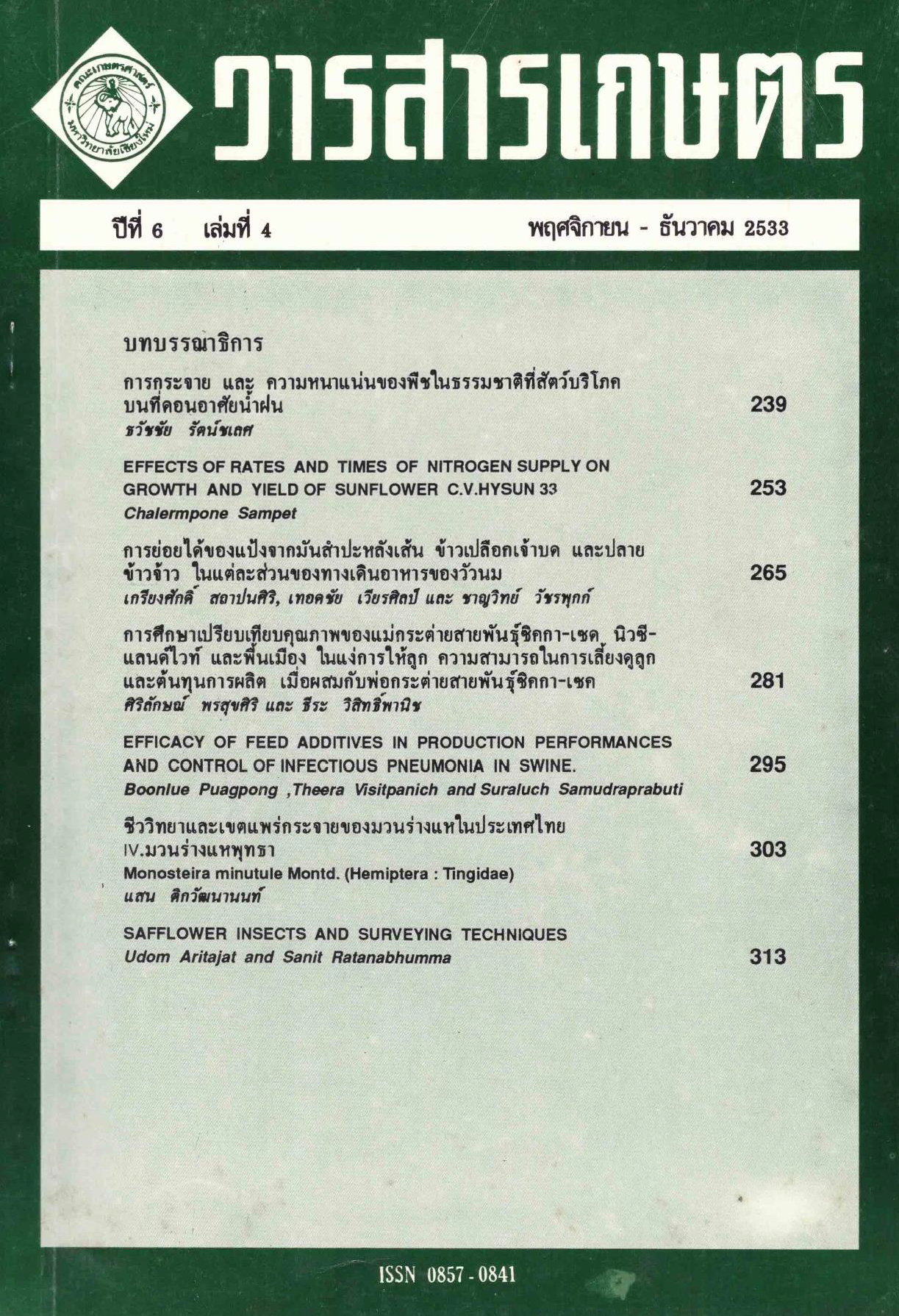EFFECTS OF RATES AND TIMES OF NITROGEN SUPPLY ON GROWTH AND YIELD OF SUNFLOWER C.V. HYSUN 33
Main Article Content
บทคัดย่อ
A study on the effects of rates and timing of nitrogen supply on the growth and yield of sunflower cv. Hysun 33 conducted at the Faculty of Agriculture, Chiang Mai University from November 1988 to March 1989 under lowland irrigated conditions. A low rate and a high rate of nitrogen (50 and 150 kgN/ha, respectively) were applied at the following stages of growth: (i) at sowing, (ii) at sowing and after weeding, (iii) at sowing and budding, and (iv) after weeding and budding. The experimental design consisted of a split plot with the two N-levels used as the main plot and with timing of application used as the sub-plot. A nil application of N was included in the experiment as check plot.
There was no significant difference in seed yields due to the timing of N application. The split application of nitrogen, however, did result in increases in seed yields. A highest yield of 3.4 ton/ha was recorded. In comparison to the check plot, seed yields increased by 16% with the low level of N application and by 42% with the high level of N application. Seed oil contents tended to decrease as increasing N levels. A contrary result was observed for protein content. Mean values of between 42.9% and 46.1% for oil content and 16.1% and 23.1% for protein content were observed. Leaves demonstrated a greater capacity for remobilization of both DM and N to seeds than did stems or petioles and capitulum. As the application of N increased there was an accompanying decrease in the remobilization percentage. Remobilization was between 21.1% and 34.6% for DM in leaves and between 38.4% and 75.4% for N in leaves. The lowest remobilizations for DM and N were between 3.4% and 13.7% and 57.8% and 62.9% in stems plus petioles, repectively.
Article Details
เอกสารอ้างอิง
Gardner, F.P., Rearec, R.B. and Mitchell. R.L. (1985). Physiology of Crop Plants. owa State University Press, Ames.
Massey, J.H. (1971). Effects of nitrogen rates and plant spacing on sunflower seed yields and other characteristics. Agron J. 63 : 137-138.
Muirhead, W.A.,Low, A. and White, R.J.G. (1982). The response of irrigated sunflower cultivars to nitrogen fertilizer. In: Proc. 10th International Sunflower Confer ence, Kochman, .K. (ed.) Australian Sunflower Association, Toowoombe, Qid., p. 82-85.
Reuter, D.J. and Robinson , J.B. (1986). Plant analysis : An interpretation manual. In kata Press, Melbourne.
Steer, B.T. and Hocking, P.J. (1984). Nitrogen nutrition of sunflower (Helianthus annuus L.): Acquisition and partitionning of dry matter and nitrogen by vegetative organs and their relationship to seed yield. Field Crop Research 9:237-251.
Steer, B.T., Low, A. and Hocking, P.J. (1985). Nitrogen nutrition of (Helianthus annuus L.): Yield response of seven genotypes and interaction of heterosis with nitrogen supply. Field Crop Research 12 : 1-6.
Steer, B.T., Coaldrake, P.D., Pearson, C.J. and Canty, C.P. (1986). Effects of nitrogen supply and population density on plant development and yield components of irrigated sunflower (Helianthus annuus L.) Field Crop Research 13:99-115.
Valle, M.R.R. (1981). Ph.D. diss. University of Florida, Gainesville.


